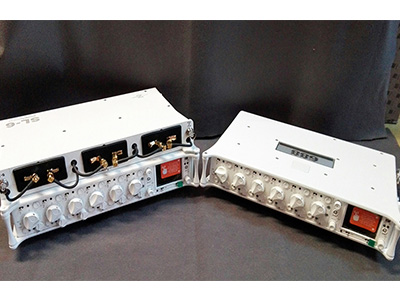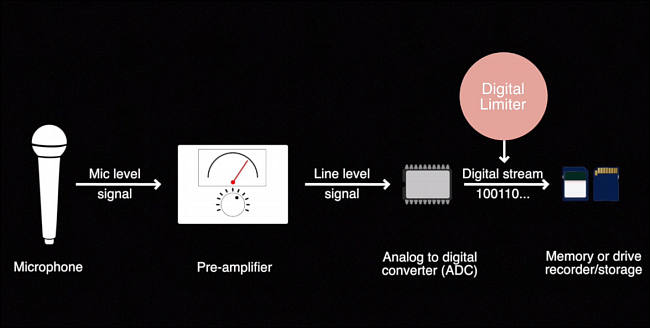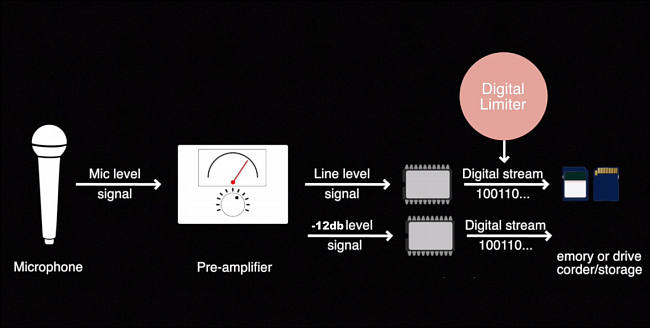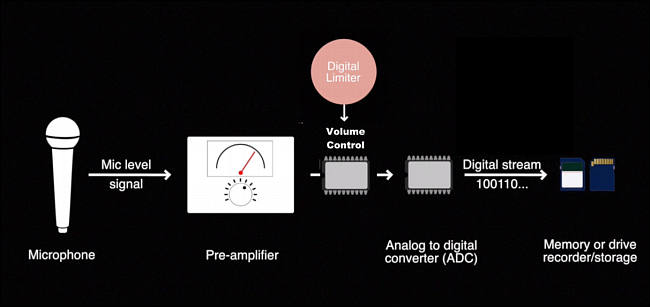
-
@Grimor ah. Yeah I only mentioned it as when I looked it up that was a "major feature". I don't quite know when that would be useful, but for police interviews yes it probably would.
@Vitaliy_Kiselev I believe that the Zoom F8 allows setting independent gain for safe tracks. So user can set level much lower than -12. Or in another situation one could use safe dual gain to "cheat" and record soft material at same time as loud material. (As long as they are not happening at same time obviously) for example if an actor had dialogue that went from whispering to yelling.
-
Sometimes even -12db can be distorted, if only mildly. Use a repair software if it is - like RX6. There is an 'De-Clip' function, the only one I have found that actually makes the audio usable afterwards, its magic.
Example can be Canon C200 interview audio from CG, source had not large but many clippings even at safe track.
-
I have contacted Sound Devices and they assured me the Rotary encoders are smooth regardless of what mode they are set to.
So hopefully that should mean that if we change levels during recording (riding the gain depending on audio situation) there should be no problem with terraced volume or glitches.
-
Yeah, I have had that issue before, (with actors actually). Sometimes even -12db can be distorted, if only mildly. Use a repair software if it is - like RX6. There is an 'De-Clip' function, the only one I have found that actually makes the audio usable afterwards, its magic.
I haven't looked at the pmd661 @Grimor. File encryption? Must be good for police / military usage?
-
Thanks @alcomposer. Last day, shooting with childrens, some of them shouted at the microphone for no apparent reason. kid stuff. Record with my pmd661 in dual stereo mode.One of the channels was -12db. I´ll try to fix.
-
Good news @Vitaliy_Kiselev, looks like from this video Gain is digital. (Suppose it should be ok if it is smooth transition between volume levels?)
Checkout beginning of video and gain value setting.
More info about knobs and settings, Sound-devices has already saved a life:
Already bugs in firmware, SD will fix (stated by SD):
-
Yup, hence my comment 'as large a region as possible'. Its not worth the time trying to fix peaks, only if there is also very quiet content between issue areas.
On side note, I really want a MixPre in white:


 vatican2.jpg400 x 300 - 46K
vatican2.jpg400 x 300 - 46K -
Sometimes if levels where way off or just one guy periodically talks very loud you can be forced to use all backup file, just faster. If you are not recording in studio or quiet place no one will even notice.
-
@Grimor if you have the backup -12db then I would simply match gains and replace the region in question. Replace as large a region as possible (as there may be intra-sample clipping on other parts of the hot signal also).
I actually don't know of software that would be able to analyze the file to replace only the clipped waveforms, and anyway, if its clipped then the level is above 0dbfs, so you would need to reduce the level - or limit it anyway.
Also remember that limiting is only one aspect of audio recorders, Amplifier quality is also very important, and gain staging.
-
Depends on content.
-
When using safety track record feature the unit will only be able to use half its inputs. So the f8 gets reduced to 4 input etc. So if you are using this "feature" there is little difference between the specs of the f8 and mix pre 6.
We always use Tascam safety track feature on exhibitions. Very useful thing.
-
Looking at comparison of zoom f4/8 series, there is also a similar limitation to track count and safety -12db track:
When using safety track record feature the unit will only be able to use half its inputs. So the f8 gets reduced to 4 input etc. So if you are using this "feature" there is little difference between the specs of the f8 and mix pre 6.
-
Looks like you can also connect Keyboard to MixPre and log metadata. Could be useful onset for more complex productions (from manual):
The use of standard USB computer keyboards is supported. When using the MixPre-6 in situations requiring extensive metadata entry, titling and wired remote control capability, a USB keyboard may be desirable.
http://cdn.sounddevices.com/download/guides/MixPre6-UG_en.pdf
-
I know that the DR100MKii has an analog limiter, and I loved using that device, especially unmanned for performance audio. So personally an analog limiter is very reassuring that the quality of the audio will be maintained in a bad situation.
It depends on that you understand under 'analog limiter'. As such recorders use Digital variable-gain amplifier https://en.wikipedia.org/wiki/Variable-gain_amplifier or digital volume control paired with amplifier. So it can be just some form of marketing term.
Also the volume knobs on the DR70d are digital as well, so you can't simply change volume during recording as it will cause audible changes in volume (volume terracing) which I am assuming as the MixPre is analog volume then that would not be the case.
I am not sure if MixPre pots are just resistors and not digitally control gain. Needs checking. But considering DR70d it is not issue of such general design, but issue either of specific hardware solution or firmware. If you have big enough steps you won't be able to tell easy digital control from analog, no way. And in the long run digital can be made cheaper and be much more stable.
-
I know that the DR100MKii has an analog limiter, and I loved using that device, especially unmanned for performance audio. So personally an analog limiter is very reassuring that the quality of the audio will be maintained in a bad situation.
So on that level the MixPre would be very useful for me, as I do lots of productions like that. MixPre looks like the best of both worlds (analog and digital) until digital limiters are designed correctly as you pointed out VK.
Also the volume knobs on the DR70d are digital as well, so you can't simply change volume during recording as it will cause audible changes in volume (volume terracing) which I am assuming as the MixPre is analog volume then that would not be the case.
Once again, this probably and should work well on a digital system, but its just not implemented in a way that is 'analog'. Pity. 99% of everything I do audio wise is digital (in DAW) just don't understand why that can't work on portable device?
-
So your view is that the MixPre's analog limiter isn't that exciting? Better to go with Zoom F4/8?
You must think yourself here and consider your needs and check more info about limiters implementation behavior.
-
So your view is that the MixPre's analog limiter isn't that exciting? Better to go with Zoom F4/8? (I'm kind of over the Tascam for a few 'firmware' related reasons.
-
This function cannot be enabled if more than two channels are selected for recording or if the two selected channels prevent the recording of a stereo pair (for example, CH1 and CH3).
But it fully proves my theory.
It also explains why video approach is wrong. As he uses loud voice well above initial level clipping, it is above 12db such limiter has. In most situations were levels are set right initially it won't be possible to tell difference if signal is within this 12db.
-
Tascam DR70d implementation of dual level recording is very limited (no pun intended):
This function cannot be enabled if more than two channels are selected for recording or if the two selected channels prevent the recording of a stereo pair (for example, CH1 and CH3).
Seriously getting annoying to have features that don't use the whole device, (4 channels etc). So many stupid limitations to remember.
What is nice about MixPre is that the limiter works flawlessly on all 4 channels. Simple to remember. Especially in stressful onset situations, we need gear we can just turn on - press record - and get usable material from.
-

And this is really wrong understanding of digital limiter.
In reality in Tascam such limiter seem to be made such

And this is proper implementation


 sample488.jpg650 x 328 - 20K
sample488.jpg650 x 328 - 20K
 sample489.jpg650 x 328 - 21K
sample489.jpg650 x 328 - 21K
 sample490.jpg650 x 307 - 19K
sample490.jpg650 x 307 - 19K -
I would much prefer to use an analog limiter if I will use this for show recording from desk. (which is my main purpose) as I can't constantly monitor the mix. Remember that the Tascam's DR70d limiter adds 12db of noise, which normally shouldn't be an issue- only if there are quite sections of audio.
Tascam's DR70d has dual level recording on top of this. Looking at specs it is -12 db, so actually your limiter noise can come from implementation where it just use backup channel and pushes it up.
One thing that I also understand that Tascam does not care about limiter performance much, as well as Zoom. At least for now. As good design allows to make digital limiter without all issues that show.
-
I would much prefer to use an analog limiter if I will use this for show recording from desk. (which is my main purpose) as I can't constantly monitor the mix. Remember that the Tascam's DR70d limiter adds 12db of noise, which normally shouldn't be an issue- only if there are quite sections of audio.
The audio could peak without me knowing, and I need some reassurance that it won't turn into digital rubbish.
Has anyone have experience with the MixPre6 and SD Cards? Are they reliable, any issues similar to Tascam DR70d? (such as erasing SD Card causes unit to have write errors?):
V1.13 FIXES... When using the erase format function, writing speed would slow and a Write Timeout error would occur sometimes. This has been fixed.
(Mind you I have run 1.13 and still experienced this issue, so I don't know if its fixed)
-
Zoom also don't have analog limiters. MixPre is analog limiter.
I think it is quite old story. In modern CPU based recorders it does not really matter, if gain is digitally controlled (and it is in almost all). Implementation can be slightly lacking, but it is more question to programmers and engineers.
In present reality all design of digital recorders is horrible and does not match existing chips.
Howdy, Stranger!
It looks like you're new here. If you want to get involved, click one of these buttons!
Categories
- Topics List23,964
- Blog5,723
- General and News1,342
- Hacks and Patches1,151
- ↳ Top Settings33
- ↳ Beginners254
- ↳ Archives402
- ↳ Hacks News and Development56
- Cameras2,361
- ↳ Panasonic990
- ↳ Canon118
- ↳ Sony154
- ↳ Nikon96
- ↳ Pentax and Samsung70
- ↳ Olympus and Fujifilm99
- ↳ Compacts and Camcorders299
- ↳ Smartphones for video97
- ↳ Pro Video Cameras191
- ↳ BlackMagic and other raw cameras121
- Skill1,961
- ↳ Business and distribution66
- ↳ Preparation, scripts and legal38
- ↳ Art149
- ↳ Import, Convert, Exporting291
- ↳ Editors191
- ↳ Effects and stunts115
- ↳ Color grading197
- ↳ Sound and Music280
- ↳ Lighting96
- ↳ Software and storage tips267
- Gear5,414
- ↳ Filters, Adapters, Matte boxes344
- ↳ Lenses1,579
- ↳ Follow focus and gears93
- ↳ Sound498
- ↳ Lighting gear314
- ↳ Camera movement230
- ↳ Gimbals and copters302
- ↳ Rigs and related stuff272
- ↳ Power solutions83
- ↳ Monitors and viewfinders339
- ↳ Tripods and fluid heads139
- ↳ Storage286
- ↳ Computers and studio gear560
- ↳ VR and 3D248
- Showcase1,859
- Marketplace2,834
- Offtopic1,319





